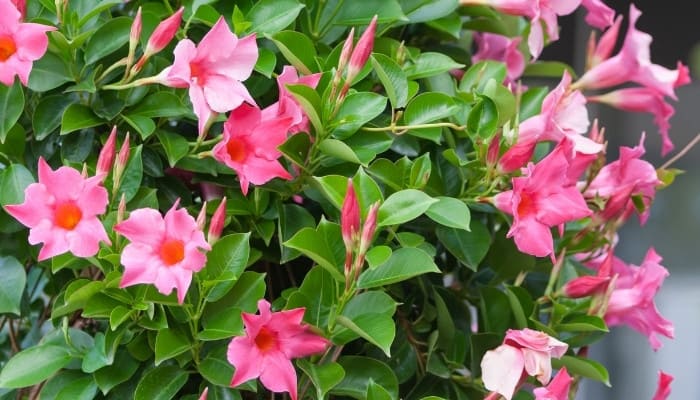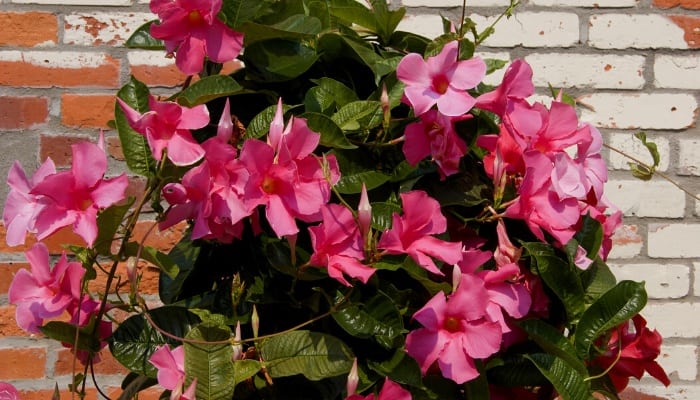The Mandevilla genus is made up of different species that have either climbing or bushy characteristics, and are easily recognizable for their vibrant trumpet-shaped flowers.
Sometimes, even when your Mandevilla is looking healthy, you may begin to notice that it isn’t covered in its usual dazzling display of flowers.
Why is my Mandevilla not blooming? Varieties in the Mandevilla genus may not be blooming due to a lack of sunlight, lack of nutrients, or inconsistent moisture levels. It may also have difficulty blooming if its location has been changed, it hasn’t reached maturity, or it has become rootbound in its container.
Continue reading to understand the 7 most common causes of your Mandevilla not blooming and solutions to remedy the situation so it will begin blooming again soon!
Check out the fertilizers mentioned to help correct any nutrient deficiencies for bountiful blooms.
Mandevilla Not Blooming – 7 Causes (With Solutions)
It’s easy to notice when your Mandevilla isn’t blooming since it is usually filled with buds by early summer. If you haven’t noticed buds forming by the end of spring, there is likely an issue affecting its health.
See the 7 most common causes below to help diagnose and treat any issues ASAP.
1. Not Enough Sunlight
This is a sun-loving plant that prefers direct sunlight over shade but can handle partial shade.
Without sufficient light, it will show signs of an overall lack of vigor and yellowing leaves, which will lead to a lack of energy to produce flowers that season.
Solution
Ensure your Mandevilla is getting 6-8 hours of sunlight per day. If it is potted, relocate it to a sunnier location. Also, try pruning back other plants nearby to allow for more sunlight to reach the plant.
2. Lack of Nutrients
Plants need nitrogen, phosphorous, and potassium as their main nutrients as well as other trace minerals. If a plant isn’t blooming, it usually lacks enough phosphorous and potassium in the soil.
Solution
Apply a well-balanced fertilizer seasonally to supply it with everything it needs to grow and flower.
This will provide your Mandevilla with ample nutrients year round so that it does not lack what’s needed to bloom.
Use one of the three fertilizers listed below to give it a specific boost in nutrients when it has healthy leaves but isn’t blooming.
3. Conditions Too Dry
Mandevilla is a tropical and subtropical species that requires consistent moisture to grow and bloom. They should be planted in well-draining soil that is always kept generally moist but not overly dry.
Solution
Aim to water your Mandevilla two times per week with about 2 inches of water a week. Sometimes it will not require that much watering, so always check the moisture level before continuing to water the plant.
4. Waterlogged Soil
Overly wet soil will create anoxic growing conditions that don’t allow for the plant’s roots to absorb oxygen.
This will lead to an unhealthy plant, and it will not be able to produce healthy new growth for buds to grow.
Solution
Check the moisture level to ensure the plant is not sitting in waterlogged soil or in a pot with no drainage. They prefer moist tropical environments, so they do require watering 1 or 2 times per week.
Don’t water a second time that week or skip watering for a full week if the soil seems overly saturated.
5. Plant Is Rootbound
If your Mandevilla is growing in a pot or in an area heavily planted with other plants, its roots may have run out of space to grow and absorb ample water, nutrients, and oxygen.
Solution
Repot your plant if it has been growing in the same container for over 2 years.
If you notice roots protruding from the soil or it seems like there are more roots than soil, replant your Mandevilla in a new larger pot or into the ground if in a warm-enough climate.
6. Plant Still Immature
While most Mandevilla species are fast-growing vines, growing about 6 to 8 feet per season, they may not be old enough to flower.
If your vine was planted from a propagated cutting or seed, it will take one to two seasons before it begins to bloom.
Solution
Time is the only solution to allow the plant to mature to an age where it is strong enough to flower.
Seasonally fertilizing the vine will help it grow with abundant nutrients and have everything it needs to flower when it is ready to.
7. Recently Moved Indoors
Since this is a tropical species, it may need to be brought indoors when the season turns cold. However, relocating this flowering species indoors after it has been growing outdoors can stress it.
It may dislike the change in humidity, lack of natural light, and lack of temperature fluctuations.
Solution
Ensure your Mandevilla is receiving full sun, at least 6 to 8 hours per day while inside. It can also help to mist the plant regularly to ensure it has enough moisture in its growing area.

Mandevilla Flowering Season
The season you should see copious buds forming on your Mandevilla is in the late spring.
Once summer comes into season, the blooms should begin to open and continually do so until the fall or the first frost comes.
Best Fertilizer for Mandevilla
While all three fertilizers listed below are great ways to help get your Mandevilla blooming, Jack’s Classic Bloom Booster is the best choice since it will help grow abundant buds and leaves and a strong root system.
Miracle-Gro Bloom Booster Flower Food
This fertilizer is specially formulated with an NPK of 10-52-10 to heavily increase your plant’s phosphorus levels, which should give it everything it needs to produce plentiful blooms.
Apply it every one to two weeks in the spring until blooming occurs.
Scotts Super Bloom
With an NPK of 12-55-6, its high level of phosphorous is specifically formulated for increased blooms only.
It does have nitrogen and potassium as well, but it provides the highest dose of phosphorous in comparison.
Jack’s Classic Blossom Booster
This fertilizer has an NPK of 10-30-20. It is high in phosphorous and potassium, which should help to favor strong blooms as well as an overall strong root system for the plant.
It is a slow-release formula, so applying it once should feed your plants for 4 months.
Related Questions:
Is Miracle-Gro Good for Mandevilla?
Using Miracle-Gro is a good way to fertilize your plants, but choosing the correct type is important.
Many fertilizer mixes will give copious amounts of nitrogen with limited amounts of phosphorous and potassium. This can cause excessive vegetative growth while limiting the plant’s flowering abilities.
Chose a specifically formulated mixture made for flowering plants to ensure you aren’t prohibiting your Mandevilla from blooming rather than helping it flower!
Miracle-Gro Rose or Bloom Booster are your best options to feed your Mandevilla when considering Miracle-Gro.
How Do I Get My Mandevilla To Climb?
Your Mandevilla will need something to climb up if you want it to cover a wall or fence, and you will need to train it to grow in a certain location until it is established.
Since they have tendrils that will reach to grab onto something and don’t grow roots that can adhere to brick or other surfaces, it may be necessary to put up trellising or guidewire for your plant to grow onto.
Conclusion
A Mandevilla with no blooms is still beautiful, but this is nothing compared to its showy display when it is in full bloom.
Try diagnosing what the issue could be and correcting it. It may be more than one issue and need a few changes to get it to produce flowers again.
Don’t worry, Mandevilla are vigorous growers and should reward you quickly if you give them everything they need to thrive!

